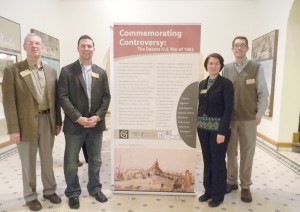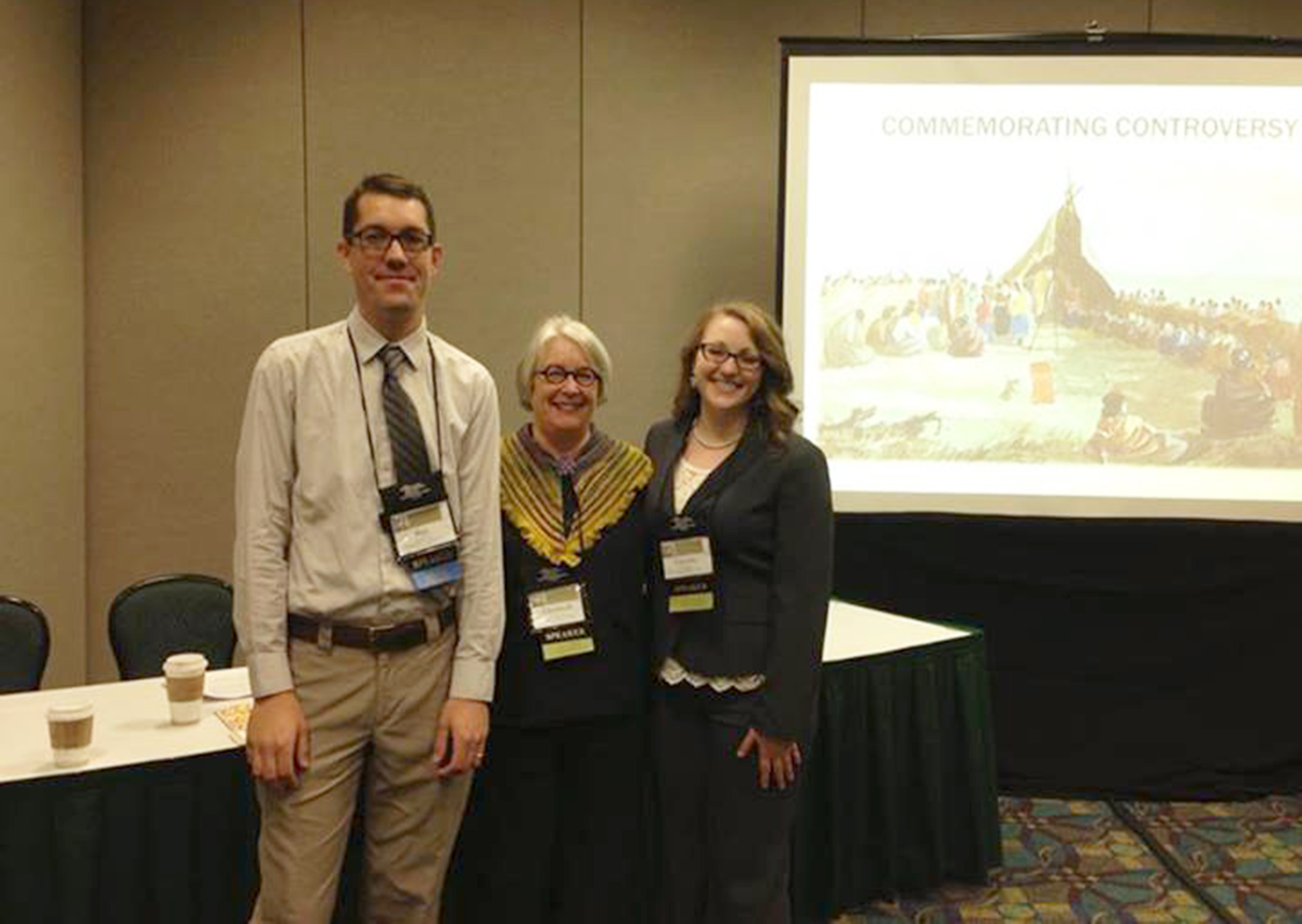A traveling exhibit produced by the 2012 January Interim course, Commemorating Controversy: The U.S.-Dakota War of 1862, recently received national recognition from the American Association of State and Local History (AASLH) after receiving a nomination from the Minnesota Historical Society.
English Professor Elizabeth Baer, Executive Director of the Nicollet County Historical Society Ben Leonard, and Senior English Major Victoria Clark, who all held integral roles in creating the exhibit, traveled to Birmingham, Alabama to receive the National Merit Award on Sept. 20. The trio also participated in a panel discussion at the conference, hoping to educate and inspire other organizations to pursue similar projects.
Baer, who taught the course, describes the AASLH as a professional organization for state and local historical societies. The annual conference and award ceremony seeks to recognize model programs.
Baer and the class worked closely with Leonard on the exhitbit.
“It’s my favorite national conference to go to as a museum professional,” Leonard said. “I think Birmingham was particularly fitting because a lot of it had to do with civil rights, and the theme of the conference was really talking about difficult history.”
“The more that we recognize that [the complexity of history and human interactions], the more of a chance we have for empathy and perspective in our daily lives,” Leonard said.
The 2012 January Interim class of 15 students directly confronted a vivid example of difficult history as they sought to give voice to the often-overlooked chapter of the broken treaties and conflicts between the United States government, settlers, and the Dakota people.
Baer noted that prior to the course, most of the students had little awareness of the conflict, and that this area of history is often unknown to many Dakota people as well.
“2012 was Gustavus’ Sesquicentennial, but it was also the Sesquicentennial of this war, and my hope in proposing this class and inviting Ben to teach with me was to raise awareness on the part of the college community about what was going on in Minnesota when Gustavus opened its doors,” Baer said. “I felt that was important as part of our Sesquicentennial celebration, to recognize the context in which we opened.”
The project received funding from a Sesquicentennial grant system established by the college as well as several other grant sources. This financial support also made possible a well-attended lecture series on campus.
“This war in many ways is still being fought in Minnesota,” Baer said. “It’s still as Thomas Maltman called it, ‘a living wound,’ and one of the things we wanted to do in our course was to engender conversation, and discussion about the war, particularly between the descendants of settlers, and the descendants of Dakota people involved in the war.”
The course culminated in a display of 12 panels created by the students with the design assistance of a local graphic designer.
“The level of work that the students did was really above and beyond, and I think that it was professional quality. I think that it speaks well of those students and Gustavus that this wasn’t something that people didn’t look at the exhibit and say well, this is pretty good for a student, they look at the exhibit as a professional exhibit and are very impressed with it,” Leonard said.

Debuting at the 2012 Building Bridges Conference, the exhibit began to travel to various colleges, museums, and other institutions around the state. Growing demand prompted the creation of additional copies.Baer and Leonard estimate that over 30,000 Minnesotans have experienced the exhibit since it began its circulation, spreading awareness and fostering discussion.
Clark, who was a student in the course, spoke on her experience at the award ceromony and the significance of the award.
“It was such an honor to receive the award with Professor Baer and Ben. I see the award as a recognition of an entire community—a community who came together to tell a painful story. I see the award as recognition of every Dakota person who helped us interpret as history that has often been disenfranchising to Native people, I see the award as recognition of every person who attended the community lectures and asked difficult questions,” Clark said.
Clark, as a result of her interest in the course, is currently enrolled in a semester-long research seminar at the Newberry Library in Chicago, where she is researching more textual material pertaining to the US-Dakota War.
The exhibit has been featured in the Lincoln Cottage in Washington, D.C., and Baer said it will open in the Museum of the American Indian in New York City in January of 2014. Later next year, it will travel to the National Museum of the American Indian in Washington D.C.
“It’s incredibly meaningful to me—I would have to say that teaching this class is probably the most rewarding teaching experience I’ve had in my 40 year teaching career,” Baer said. “What the students did was to create something that has had enormous ripple effects, and for that impact to be recognized, it just means an enormous amount to me, that the class has really changed lives.”
Leonard also spoke of the exhibit’s success in relation to public interest and the anniversary of the war.
“I think that this is the project that keeps on giving. I think it speaks to the quality of work that the students did, and the honest, heartfelt approach that they had,” Leonard said.
The display panels have been installed in the Nicollet County Historical Society Treaty Site Museum, and a copy is also available in the Folke Bernadotte Memorial Library. Anyone interested in viewing or using the library display is encouraged to contact Professor Baer.
